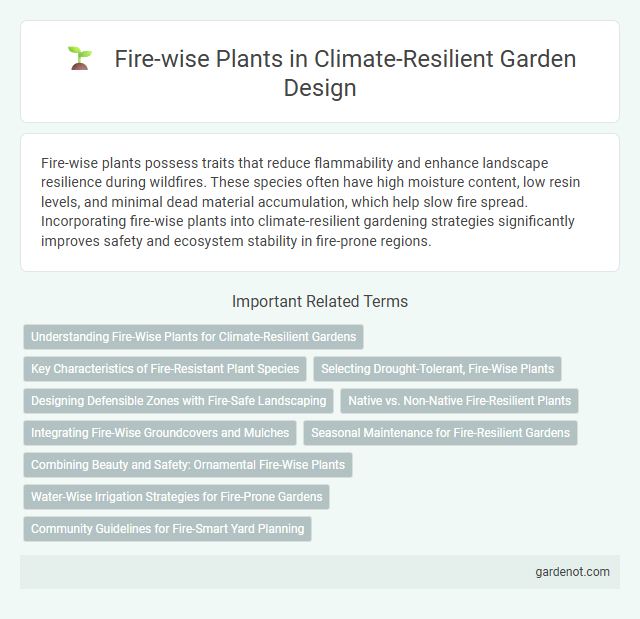Fire-wise plants possess traits that reduce flammability and enhance landscape resilience during wildfires. These species often have high moisture content, low resin levels, and minimal dead material accumulation, which help slow fire spread. Incorporating fire-wise plants into climate-resilient gardening strategies significantly improves safety and ecosystem stability in fire-prone regions.
Understanding Fire-Wise Plants for Climate-Resilient Gardens
Fire-wise plants possess high moisture content, low resin levels, and minimal volatile oils, making them less flammable and vital for climate-resilient gardens. Incorporating native, drought-tolerant species such as manzanita, California lilac, and ceanothus reduces fire risk and supports ecosystem stability. Strategic placement and regular maintenance of fire-wise plants create natural firebreaks, enhancing garden resilience against wildfires.
Key Characteristics of Fire-Resistant Plant Species
Fire-resistant plant species possess thick, moisture-rich leaves that reduce flammability and slow fire spread. These plants typically have low resin or oil content, minimizing the intensity of flames during wildfires. Deep root systems and open branching structures further enhance their ability to withstand fire damage and promote landscape resilience.
Selecting Drought-Tolerant, Fire-Wise Plants
Selecting drought-tolerant, fire-wise plants is essential for creating landscapes that withstand both water scarcity and wildfire risks. Native species such as manzanita, ceanothus, and yucca possess natural adaptations like deep root systems and low resin content, reducing flammability and promoting landscape resilience. Integrating these plants enhances soil moisture retention and minimizes the need for supplemental irrigation, supporting sustainable, climate-resilient gardening practices.
Designing Defensible Zones with Fire-Safe Landscaping
Designing defensible zones with fire-safe landscaping involves selecting fire-wise plants that have low resin content, high moisture levels, and minimal leaf litter accumulation to reduce fuel for wildfires. Strategic placement of these plants creates buffer zones that slow wildfire spread and provide firefighters with safer areas to control fires. Incorporating drought-tolerant fire-resistant species such as succulents, deciduous trees, and herbaceous perennials enhances landscape resilience in wildfire-prone regions.
Native vs. Non-Native Fire-Resilient Plants
Fire-wise planting emphasizes the use of native fire-resilient plants, which are adapted to local climate and soil conditions, enhancing ecosystem stability and reducing wildfire risk. Non-native fire-resilient plants may survive fires but often lack the ecological benefits and can sometimes become invasive, disrupting native habitats. Prioritizing native species supports biodiversity, soil health, and long-term resilience in fire-prone landscapes.
Integrating Fire-Wise Groundcovers and Mulches
Fire-wise groundcovers such as creeping thyme and native sedums create effective barriers that reduce fire fuel and lower flame intensity near structures. Using mulch types like gravel or volcanic rock further minimizes combustible materials while promoting soil moisture retention critical for plant resilience. Integrating these groundcovers and mulches into landscape design enhances fire resistance by limiting the spread of flames and reducing heat absorption.
Seasonal Maintenance for Fire-Resilient Gardens
Seasonal maintenance for fire-wise plants in fire-resilient gardens involves regular pruning to remove dead branches and reduce fuel loads, especially during dry seasons when fire risk peaks. Mulching with non-flammable materials helps retain soil moisture and suppresses weeds that can serve as kindling. Consistent watering schedules and the removal of leaf litter further enhance plant health and minimize fire hazards throughout the year.
Combining Beauty and Safety: Ornamental Fire-Wise Plants
Ornamental fire-wise plants such as lavender, rosemary, and ornamental grasses provide aesthetic appeal while reducing fire risk through low flammability and high moisture content. Incorporating these species into landscaping enhances climate resilience by creating defensible spaces that slow wildfire spread without sacrificing beauty. Strategic placement and plant selection optimize both fire safety and garden elegance in fire-prone regions.
Water-Wise Irrigation Strategies for Fire-Prone Gardens
Fire-wise plants reduce flammable vegetation, lowering wildfire risk in vulnerable gardens. Implementing water-wise irrigation strategies such as drip systems and soil moisture sensors ensures efficient water use while maintaining plant health in fire-prone areas. Selecting drought-tolerant species combined with targeted watering minimizes ignition potential and promotes climate-resilience.
Community Guidelines for Fire-Smart Yard Planning
Fire-wise plants play a crucial role in community guidelines for fire-smart yard planning by reducing fuel load and slowing fire spread near homes. Selecting drought-tolerant, low-resin species like succulents, lavender, and native grasses enhances landscape resilience against wildfires. Proper spacing, regular pruning, and maintaining defensible space around structures align with fire-wise landscaping principles to protect communities from fire hazards.
Fire-wise plant Infographic

 gardenot.com
gardenot.com